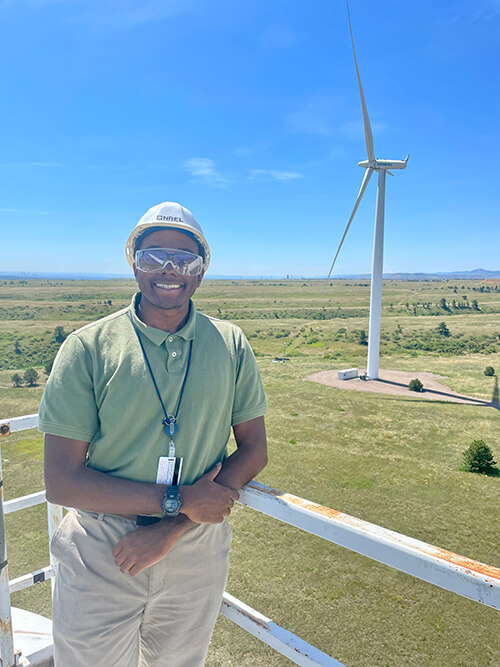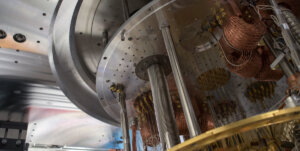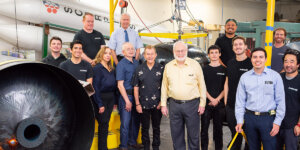
Interns and researchers at the National Renewable Energy Laboratory together for a hike at Mount Falcon Park, CO
The National Renewable Energy Laboratory (NREL) is a research institute dedicated to innovation in renewable energy and energy efficiency technologies. For Morgan Jones, whose thesis in fluid dynamics is supervised by Mitul Luhar, Henry Salvatori Early Career Chair and associate professor of Aerospace & Mechanical Engineering and Civil & Environmental Engineering, NREL has been an ideal site to test out ideas developed in his PhD research.
During a previous internship at the Naval Undersea Warefare Center in Newport, Rhode Island, Jones explored bioinspired designs for marine devices with flapping foils as an alternative to traditional propellor-based vehicles – especially relevant when it comes to rethinking energy-efficient sources for underwater robots. In subsequent internships at NREL’s Colorado campus, Jones’ research experience aligned perfectly with one of the organization’s initiatives known as “Powering the Blue Economy” which partly involves investigating the potential ways to extract power from tides and the ocean.
We caught up with Jones to get a sense of what powers his own thinking – and where the pursuit of new knowledge will take him next.

Morgan Jones, on site at the NREL Flatirons, CO, campus
What first inspired your interest in energy efficiency and renewable energy technologies?
As an undergraduate, I first became interested in wind energy when I encountered an innovative research group known as the Dabiri Lab at Caltech. This group focuses on bioinspired fluid dynamics, and one of the papers that really caught my interest was titled “Fish Schooling as a Basis for Vertical-Axis Wind Turbine Farm Design.” I had the opportunity to meet Professor John Dabiri and his graduate students – since then, it’s been my goal to deepen my experience in renewable energy.
What are you working on at the moment?
My work currently involves using data-driven methods to better understand high-dimensional data that can be obtained from experiments or simulations in fluid dynamics. In particular, I have studied two different methods: Dynamic Mode Decomposition (DMD) and Lagrangian analysis, which are two different ways to capture the dominant patterns from a fluid flow. I am currently applying these techniques to experimental data generated by the wake of a flapping fin in a large-scale water channel.
These bioinspired fins have applications in both marine propulsion and harvesting tidal energy. Given the complexity of the flow-fields they create, the development of reduced-order (or interpretable) models of these wakes is essential for understanding the potential for these systems to impact power production and efficiency.
How were you introduced to the NREL internship program?
I was part of the NREL GEM Internship program, which is part of the GEM fellowship. I learned about this fellowship during my time as an undergraduate and applied during my first year as a graduate student at USC. The fellowship involves interning at a national lab or a company partnered with the GEM Consortium, and I picked NREL primarily because I was interested in wind turbines and water power.
What did you enjoy most about the internships at NREL?
For my work as an intern in the summer of 2023, I had four different mentors that I worked with: two in the marine energy research group, Hannah Ross and Toan Tran, and two in the wind energy group, Cory Frontin and Mayank Chetan. Learning from multiple mentors was a fantastic opportunity and I had the chance to collaborate with researchers in both the wind and water power groups. While I was in Colorado, I also really enjoyed going on hikes with interns and researchers at NREL, making the most of the spectacular landscape!
What are the benefits of being a returning intern at NERL, and how has your experience changed and developed between the different internships?

Wind turbines at the NREL Flatirons campus, CO
For my first internship in summer 2022, I was required to work remotely due to the pandemic. That year, I worked with a researcher named Levi Kilcher and focused on tidal resource assessment of Cook Inlet in Southern Alaska. Despite the program being remote, Levi and NREL’s water power group hosted me to visit their Colorado laboratory for a week. That visit was an outstanding experience, as I transitioned from the urban environment of Los Angeles to the natural immersion of Flatirons. Within this week, I was able to meet many of the other researchers and to present elements of my graduate research to the water power group. This week-long visit made me determined to experience what it was like to work there in-person for a full summer.
I therefore had the great fortune of being able to return to the Flatirons campus in the summer of 2023. In collaboration with several interdisciplinary researchers, I assisted with the use of software to optimize a small-scale tidal turbine for maximum power production. This was a really fun project, because I was able to learn how to utilize and modify software from NREL’s wind energy repository to achieve a specific end goal.
What are your goals for your current research, and what impact do you hope your work will achieve?
I have found the availability of data and open-source programs from previous research to be incredibly helpful for me. Likewise, NREL’s wind and water power groups value the accessibility of open-source software and data sharing for both industry and academic groups.
I hope that the work I produce in my graduate research can be equally useful for other researchers in the fields of data science and fluid dynamics. So, one of my short term goals is to make the data-driven methods that I’m developing open-source, which can be useful for other researchers long term.
Upon completing my PhD program, I would like to continue research through either a postdoctoral fellowship or a research scientist position where I can utilize my skillset in data science and/or fluid dynamics. NREL is an example of a research lab where many researchers specialize in both of these fields. My work at USC has been a great way to enrich my interdisciplinary outlook, and my practical experience at NREL has opened my eyes to the power of innovation to preserve our planet.
Published on December 12th, 2023
Last updated on December 12th, 2023












